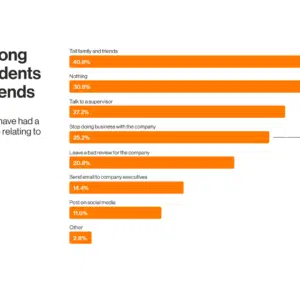



In today’s fast-paced world, customers expect fast, seamless interactions and personalized service. Long wait times, unhelpful chatbot experiences, or repeated inquiries for the same issue can quickly erode loyalty. As competition intensifies across industries, businesses must go beyond meeting expectations to consistently exceed them.
A recent study by RingCentral in collaboration with Metrigy revealed an eye-opening insight: 25% of consumers will stop doing business with a company after experiencing long hold times. The study examines consumer expectations and highlights how AI-powered tools can help businesses close the gap between current service levels and the high standards that customers demand, fostering loyalty in the process.
The true cost of hold times
This research reveals a stark contrast between how companies think they’re performing and what their customers are really experiencing. While companies aim for call hold times as short as 58.3 seconds, the reality is far different. Fewer than 3% of consumers report waiting less than a minute, and most experience much longer delays. In fact, 46.4% of consumers find current wait times unacceptable. With so many customers willing to abandon a brand after one poor experience, the stakes for businesses are higher than ever.
This disconnect isn’t limited to phone calls. When it comes to text messaging, businesses often promise sub-minute response times, yet only 26.8% of customers actually receive responses that quickly. The situation is even more pronounced with social media interactions, where just 15.6% of consumers report receiving a timely response. Unsurprisingly, the vast majority of customers are unhappy with these response times.
Customers are more patient on social channels; more than half of consumers shared that a five-minute response time on social media is acceptable. However, exceeding this time frame risks damaging customer satisfaction, as prolonged delays can lead to dissatisfaction and, in some cases, a decision to stop doing business with the company.
A disconnect between business priorities and customer expectations
The RingCentral-Metrigy study also highlights a disconnect between what businesses prioritize and what customers actually want. While 60% of consumers consider digital channels important, traditional methods of communication—like voice—are still supreme. In fact, consumers report having the best experience when they use the phone, while chatbots rank among the least satisfying interaction channels.
This is where businesses may miss the mark. While many companies have shifted their focus toward digital interactions, prioritizing 24/7 chatbot availability over human agents, this doesn’t align with today’s customer preferences. The study shows that 80% of consumers say live agent availability is more important than round-the-clock bot access. This discrepancy underscores the need for businesses to balance automation with human touchpoints to ensure they meet customer needs across various channels.
Navigating the chatbot balance
Chatbots play an important role in customer interactions, but they can sometimes fall short of fully meeting customer expectations. More than 70% of consumers are frustrated when they have to repeat themselves during chatbot interactions, and 56% say it’s difficult to escalate to a live agent when needed. While AI tools can help alleviate some of these pain points, it’s clear that chatbots alone aren’t enough to keep customers satisfied.
When developing customer service strategies, businesses may want to consider that not all customers are eager to embrace digital-only solutions. Half of consumers don’t use social media to contact companies, and a quarter avoid texting for customer service. This shows the need for businesses to offer a variety of ways to connect, including voice and email, which remain the most popular options.
How AI Is shaping a new era of customer service
AI is playing a transformative role in helping businesses bridge the gap between customer expectations and service delivery. By leveraging AI tools, companies can provide faster, more personalized responses and reduce the friction that often leads to customer dissatisfaction.
For instance, AI-driven scorecards and feedback loops allow contact centers to optimize agent performance in real time. This means faster and more accurate responses, ensuring that customers aren’t left waiting. For example, RingCentral’s AI-powered contact center solution, RingCX, has demonstrated significant improvements in key metrics, such as a 47.9% improvement in first-call resolution (FCR) and a 38.2% reduction in average handle time (AHT). These gains help reduce wait times and ensure that customer issues are addressed quickly and effectively.
RingCX also enables seamless escalation from chatbots to live agents, a key factor in improving chatbot experiences and minimizing customer frustration. By reducing the need for customers to repeat themselves, RingCX ensures a smoother, more satisfying interaction, especially when transitioning between digital and human touchpoints.
Integrating AI within UCaaS and CCaaS platforms has also proven to be a game-changer. Businesses that have adopted these integrated solutions report not only improved FCR and AHT but also faster, more reliable responses across voice, email, and digital channels. In fact, automatic callback features, which 75% of consumers value, further support the need for timely and effective customer interactions.
Turning challenges into opportunities: Leveraging AI to reduce customer frustrations
Businesses face significant risks if they fail to address common customer frustrations such as long wait times, slow digital responses, and repetitive chatbot interactions. As consumer expectations continue to climb, companies prioritizing solutions to these pain points will not only enhance customer satisfaction but foster long-term loyalty.
With RingCentral’s AI-powered solutions, businesses can make substantial improvements to their customer experiences. By thoughtfully adopting AI, companies can transform customer interactions, ensuring they keep pace with consumer demands and maintain a competitive edge.
Originally published Dec 17, 2024
Source link





No Comment! Be the first one.